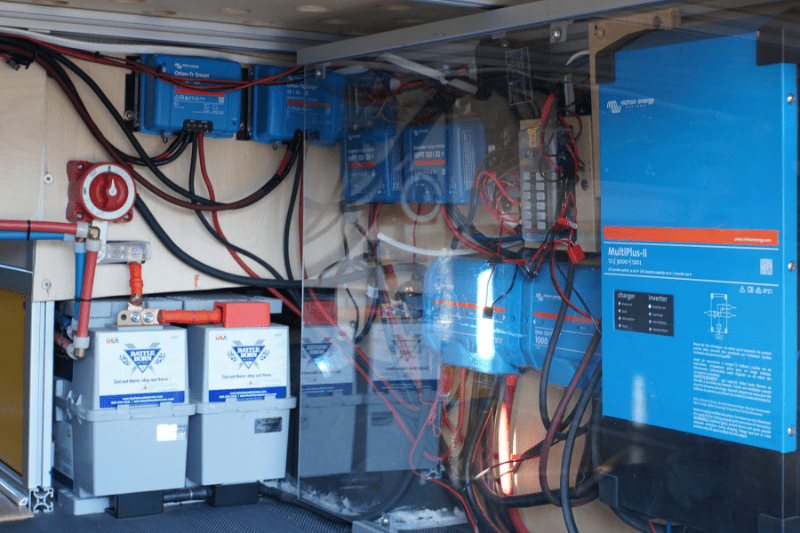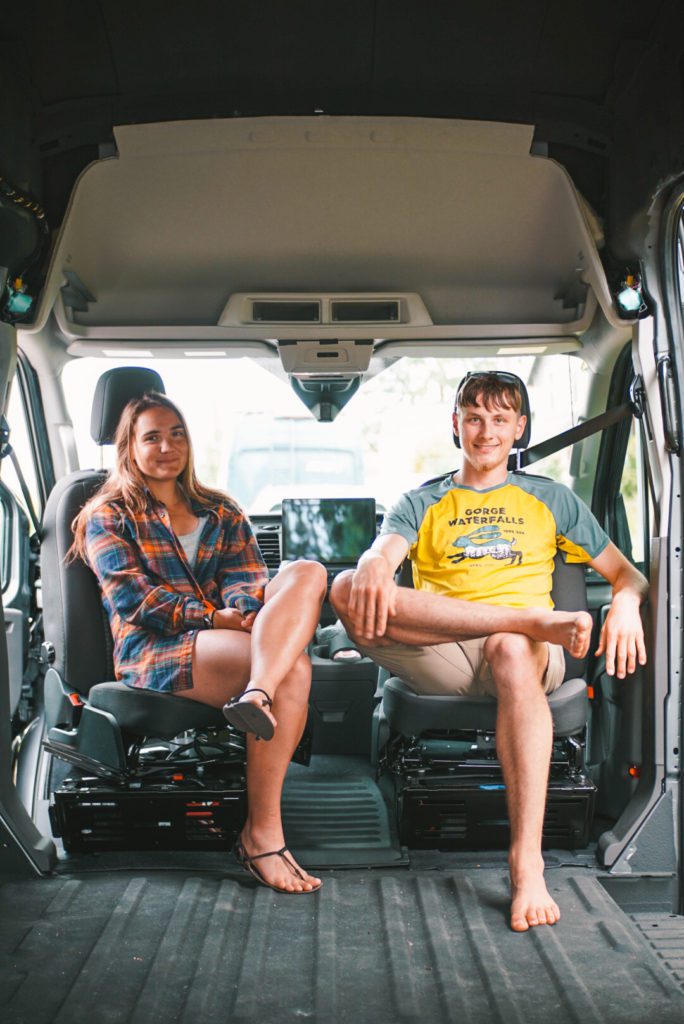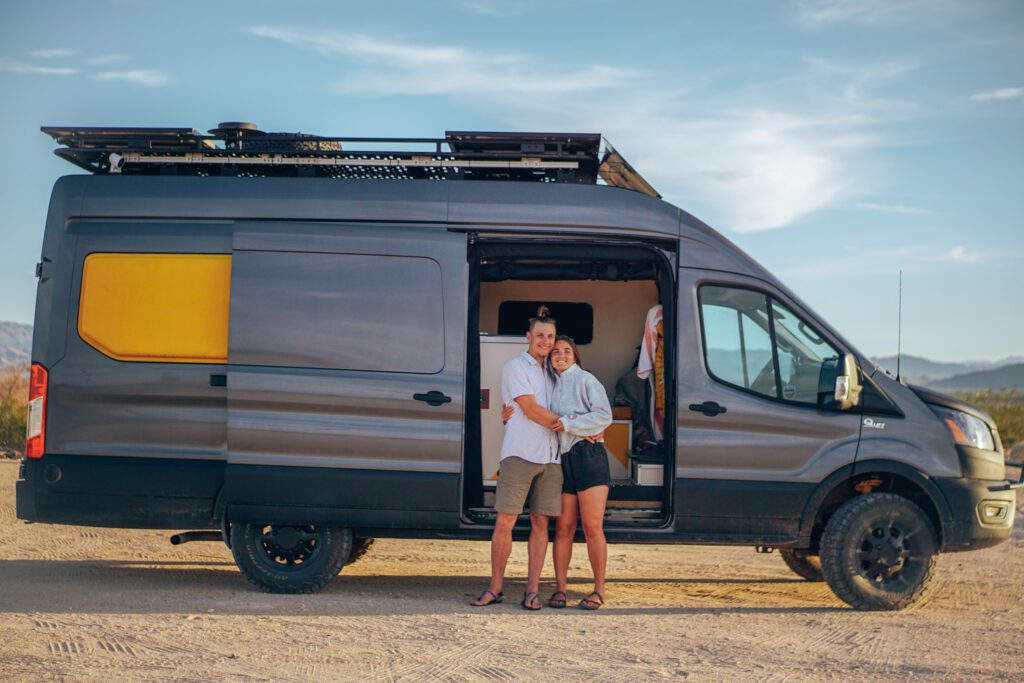Let's Talk Camper Van Electrical Systems
This particular guide is focused on helping you size the components of your camper van electrical system correctly. If that is not what you are looking for, we have two other guides that might interest you:
Start Here in the Planning Stages:
Camper Van Electrical 101
Continue Here When You Undestand the Basics:
Deep Dive into Van Electrical Systems
** Disclaimer: This blog post contains various affiliate links that provide a small kickback to us, at no additional cost to you. We truly appreciate your support if you choose to purchase through these! **

Daily Power Usage Audit
The very first step in determine in your camper van electrical needs is determine how much power you will use in one day. Once you have that number, you can extract it out to all of the components. To determine your van life daily power usage, we built the below calculator. Fill it out, and continue on with your “Total Daily Power Consumption” number. We recommend filling it out with a winter mindset so you are prepared for those months where you are inside more.
Van Life Electrical Audit
We built this calculator from scratch for you! Please let us know if you see any glitches.
Step 1: DC Power Usage
| Point of Use | Power Draw (Watts) | Hours per Day | Daily Usage (Ah) |
|---|---|---|---|
| Total DC Usage (Ah) |
Step 2: AC Power Usage
For this, voltage will default to 120V and the 15% usable power loss during the DC to AC conversion will be accounted for.
| Point of Use | Power Draw (Watts) | Hours per Day | Daily Usage (Ah) |
|---|---|---|---|
| Total AC Usage (Ah) |
| Total Daily Power Consumption (Amp Hours): |
The above number is your estimated daily power usage. We recommend having a minimum of 2 days battery capacity on board your camper van.
Sizing Your Van Batteries
We believe that your camper van house batteries should be able to “keep you powered” for 2 full days in the winter without taking in any charge. This means that the amount of battery capacity you have on board should be at a minimum 2x your Total Daily Power Consumption calculated with a winter mindset.
For our continued example, we are going to say our Total Daily Power Consumption is 180 amp hours. We are looking to have a minimum of 360 amp hours on board. So, let’s go with 400 amp hours, a nice round number.
Winter Mindset
We mention “winter mindset” often because those are the months that the solar angle is going to be lower and you are going to be inside. more. Both of those factors result in drawing your battery usage lower.
AGM vs LiFePO4
If you using LiFePO4 batteries, nothing to see here, your formula is the same!
If you are opting for AGM batteries, you will need to multiply your battery capacity by 2. So now, we have Total Daily Power Consumption x 4. This is because AGM batteries only allow for a 50% discharge floor safely. We discuss this further in our Deep Dive to Camper Van Electrical Systems.
Camper Van Battery Recommendations
You will most likely be purchasing multiple batteries, not just one. To do this, it is super simple! Just add the capacities together and wire them in parallel when the time comes. We are looking for 400ah, so we will most likely find 4 x100 ah batteries. Below our some of our recommendations for common battery sizes.
Let’s Talk Camper Van Electrical Systems
This particular guide is focused on helping you size the components of your camper van electrical system correctly. If that is not what you are looking for, we have two other guides that might interest you:
Start Here in the Planning Stages:
Camper Van Electrical 101
Continue Here When You Undestand the Basics:
Deep Dive into Van Electrical Systems


Daily Power Usage Audit
The very first step in determine in your camper van electrical needs is determine how much power you will use in one day. Once you have that number, you can extract it out to all of the components. To determine your van life daily power usage, we built the below calculator. Fill it out, and continue on with your “Total Daily Power Consumption” number. We recommend filling it out with a winter mindset so you are prepared for those months where you are inside more.
Sizing Your Van Batteries
We believe that your camper van house batteries should be able to “keep you powered” for 2 full days in the winter without taking in any charge. This means that the amount of battery capacity you have on board should be at a minimum 2x your Total Daily Power Consumption calculated with a winter mindset.
For our continued example, we are going to say our Total Daily Power Consumption is 180 amp hours. We are looking to have a minimum of 360 amp hours on board. So, let’s go with 400 amp hours, a nice round number.
Winter Mindset
We mention “winter mindset” often because those are the months that the solar angle is going to be lower and you are going to be inside. more. Both of those factors result in drawing your battery usage lower.
AGM vs LiFePO4
If you using LiFePO4 batteries, nothing to see here, your formula is the same!
If you are opting for AGM batteries, you will need to multiply your battery capacity by 2. So now, we have Total Daily Power Consumption x 4. This is because AGM batteries only allow for a 50% discharge floor safely. We discuss this further in our Deep Dive to Camper Van Electrical Systems.
Camper Van Battery Recommendations
You will most likely be purchasing multiple batteries, not just one. To do this, it is super simple! Just add the capacities together and wire them in parallel when the time comes. We are looking for 400ah, so we will most likely find 4 x100 ah batteries. Below our some of our recommendations for common battery sizes.
Sizing Your Inverter
If you will have AC power in your camper van conversion, you will need an inverter to convert DC power to AC power. To properly size your inverter, all you need to do is determine the max amount of AC load you will pull at any given time. The best way to do this is by looking at your AC Power Audit and adding up the power draws of appliances you might use together. Often times, the most power draw is from induction stove tops and blenders.
Once you have that max power draw number, choose an inverter that safely will cover that. At this point, you will want to decide if you will be utilizing shore power. If so, you will need to buy an inverter charger. If not, you can simply purchase an inverter.
Camper Van Inverter / Inverter Charger Recommendations
Sizing Your Camper Van Solar Panel Array
Determining how many solar panels you need is less straight forward than all other electrical components. It is going to depend on a variety of factors so we will ask some questions to help guide you:
How Solar Panels Replenish Your Batteries
But first, science. Let’s abstract to a very high level of how solar panels can replenish your battery bank. In a perfect world, if you have 100 Watts of Solar Panels generating power for 1 hour on a 12V system, you get 8.33 amp-hours of power (100W*1hr/12V). This however is assuming peak sun AND no blockage. Because the solar angle changes throughout the year, and as we travel, your 100W solar panel will likely not be operating at 100% efficiency.
The name of the game is to replenish our battery banks at the same, or better, rate than we discharge them. Returning to our example of using 180ah per day, let’s say we have 2 hours of peak sun (because, “winter mindset” right?). We would need 1080 Watts of solar panels to replenish this power usage every day. Of course, this is an extreme example, but you can never really count on the weather… it could be gloomy for a week! However, this is a large solar array to fit on a camper van roof, so let’s move on to how you can adjust this number:
Do you have other charging methods?
The three ways to charge up your camper van electrical system are: solar power, charging while you drive via a dc/dc charger, and shore power. A good part of deciding how much solar power you need will depend on if you have any other methods to charge. If you can charge while you drive, you can decrease your solar array wattage as driving is quite reliable as a van lifer. If you have shore power and are willing to pay for campsites to plug-in, this can also be reliable.
How much roof space is available?
Often solar arrays will be limited by roof space. If you have any combination of: roof fans, an AC unit, a sky light, or roof deck, then you will quickly learn how tight space is. For this reason, getting your priorities straight is important. Additionally, if your budget allows, opting for residential solar panels can help as they are more space efficient than, say a 100W panel. If you are going for big solar array numbers, it is more efficient to use larger panels.
Where & how do you plan to travel?
Are you a van lifer who likes to sit in one place for multiple days in a row? In that case, you can’t rely on your dc-dc charger to charge while you drive. You will need to rely more on solar power. Do you plan to spend your winters up north? The solar angle is going to be incredibly low and you will need to compensate with more wattage. Are you a desert lover? Well, you are in luck because not only does the sun shine high there, but it shines often and you can get away with less!
Pulling it all together: How much solar power do you need?
After thinking about each of the above questions, return to the base solar panel wattage you need to replenish your daily power spend and work backwards.
Sizing Your MPPT Solar Charge Controller
A MPPT Solar Charge Controller is needed to convert the voltage of the solar energy you harvest and deliver it to your batteries at the optimal voltage that is safe for them to charge at. To size your MPPT Solar Charge Controller properly, you need to know the amperage and voltage of each of your solar panels and how you are wiring them.
If your solar panels are wired in parallel, you need to take the amperage of each panel and add them together.
If your panels are wired in series, you need to take the voltage of each panel and add them together.
Now, when looking at MPPT charges controllers you will see two numbers, these are the the maximum voltage and maximum current they are rated for, respectively. Use the numbers you calculated at the beginning of this section to determine which is right for you.
Here’s a working example. We have 400W wired in parallel. Each panel (4×100) is about ~5A. This results in ~20 total amperage. We chose a 100/30 Victron MPPT Solar Controller since neither our voltage nor current will exceed what it is rated to.


That’s all for sizing your camper van electrical components!
Our goal is to break down camper van electrical into digestable chunks as we know how daunting it may be. We hope this was a great leaping off point for you to continue planning, and executing your electrical system.
Next Up:
Deep Dive into Van Electrical Systems
Sizing Your Inverter
If you will have AC power in your camper van conversion, you will need an inverter to convert DC power to AC power. To properly size your inverter, all you need to do is determine the max amount of AC load you will pull at any given time. The best way to do this is by looking at your AC Power Audit and adding up the power draws of appliances you might use together. Often times, the most power draw is from induction stove tops and blenders.
Once you have that max power draw number, choose an inverter that safely will cover that. At this point, you will want to decide if you will be utilizing shore power. If so, you will need to buy an inverter charger. If not, you can simply purchase an inverter.
Camper Van Inverter / Inverter Charger Recommendations
Sizing Your Camper Van Solar Panel Array
Determining how many solar panels you need is less straight forward than all other electrical components. It is going to depend on a variety of factors so we will ask some questions to help guide you:
How Solar Panels Replenish Your Batteries
But first, science. Let’s abstract to a very high level of how solar panels can replenish your battery bank. In a perfect world, if you have 100 Watts of Solar Panels generating power for 1 hour on a 12V system, you get 8.33 amp-hours of power (100W*1hr/12V). This however is assuming peak sun AND no blockage. Because the solar angle changes throughout the year, and as we travel, your 100W solar panel will likely not be operating at 100% efficiency.
The name of the game is to replenish our battery banks at the same, or better, rate than we discharge them. Returning to our example of using 180ah per day, let’s say we have 2 hours of peak sun (because, “winter mindset” right?). We would need 1080 Watts of solar panels to replenish this power usage every day. Of course, this is an extreme example, but you can never really count on the weather… it could be gloomy for a week! However, this is a large solar array to fit on a camper van roof, so let’s move on to how you can adjust this number:
Do you have other charging methods?
The three ways to charge up your camper van electrical system are: solar power, charging while you drive via a dc/dc charger, and shore power. A good part of deciding how much solar power you need will depend on if you have any other methods to charge. If you can charge while you drive, you can decrease your solar array wattage as driving is quite reliable as a van lifer. If you have shore power and are willing to pay for campsites to plug-in, this can also be reliable.
How much roof space is available?
Often solar arrays will be limited by roof space. If you have any combination of: roof fans, an AC unit, a sky light, or roof deck, then you will quickly learn how tight space is. For this reason, getting your priorities straight is important. Additionally, if your budget allows, opting for residential solar panels can help as they are more space efficient than, say a 100W panel. If you are going for big solar array numbers, it is more efficient to use larger panels.
Where & how do you plan to travel?
Are you a van lifer who likes to sit in one place for multiple days in a row? In that case, you can’t rely on your dc-dc charger to charge while you drive. You will need to rely more on solar power. Do you plan to spend your winters up north? The solar angle is going to be incredibly low and you will need to compensate with more wattage. Are you a desert lover? Well, you are in luck because not only does the sun shine high there, but it shines often and you can get away with less!
Pulling it all together: How much solar power do you need?
After thinking about each of the above questions, return to the base solar panel wattage you need to replenish your daily power spend and work backwards.
Sizing Your MPPT Solar Charge Controller
A MPPT Solar Charge Controller is needed to convert the voltage of the solar energy you harvest and deliver it to your batteries at the optimal voltage that is safe for them to charge at. To size your MPPT Solar Charge Controller properly, you need to know the amperage and voltage of each of your solar panels and how you are wiring them.
If your solar panels are wired in parallel, you need to take the amperage of each panel and add them together.
If your panels are wired in series, you need to take the voltage of each panel and add them together.
Now, when looking at MPPT charges controllers you will see two numbers, these are the the maximum voltage and maximum current they are rated for, respectively. Use the numbers you calculated at the beginning of this section to determine which is right for you.
Here’s a working example. We have 400W wired in parallel. Each panel (4×100) is about ~5A. This results in ~20 total amperage. We chose a 100/30 Victron MPPT Solar Controller since neither our voltage nor current will exceed what it is rated to.


That's all for sizing your camper van electrical components!
Our goal is to break down camper van electrical into digestable chunks as we know how daunting it may be. We hope this was a great leaping off point for you to continue planning, and executing your electrical system.
Thanks for being here! Happy building!
Eric + Colby
✉️ Join our mailing list for more content!
🙏🏽 If you are looking for more 1:1 van build help, we are here to help via Consulting or Travel Van Building.
[Start Here] Beginner Guides:


















